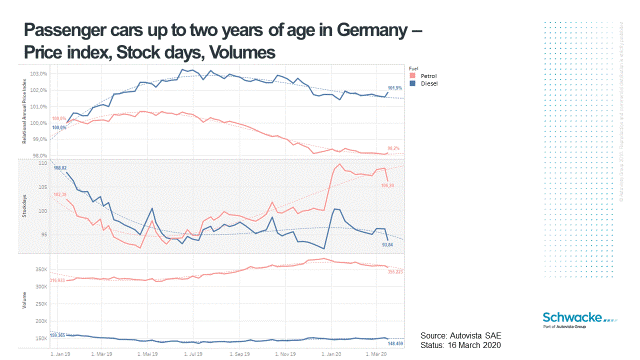Market dynamics and COVID-19 in Germany
20 March 2020

20 March 2020
We find ourselves in a situation that affects numerous countries and economic areas. In the past 20 years, there have been several crises of varying degrees of severity, including some that initially seemed much more serious from an economic perspective. The Lehman/financial crisis and the diesel crisis have both left painful scars in the automotive sector, but are hardly comparable with the current situation, writes Andreas GeilenbrÜgge, head of valuations and insights at Schwacke.
In addition to the profound impact on our daily lives, what is unusual is the weaknesses that are revealed in the global economic system that were previously considered progressive strengths, such as ‘just-in-time′, ″šlean′ or global supply chains. The economisation of basic social services such as the healthcare system now appears in a different light.
The automotive industry, as a prime example of globalisation, is correspondingly extremely vulnerable. So, what can we expect in the coming months and in the long term? Our many years of intensive experience with industry crises have taught us something banal in forecasting: you are smarter afterwards, but unfortunately only afterwards. Nevertheless, it is worthwhile to examine the influential factors through a magnifying glass.
Key drivers
Looking at the effects in a structured way, different approaches are possible. In the form of causal chains, from a European point of view, one can begin with the collapse of output from Asian suppliers in automobile production, accompanied by a sudden comprehensive reduction in travel. This severely affected a second important industry, aviation, which among other things transports both skilled personnel and management, as well as freight. It is also a car buyer as a corporate customer. The impact also extends to car-rental companies, which are attempting to phase out existing vehicles in the car-hire market at an earlier stage due to a lack of sales, and will naturally postpone new purchases. After all, this industry represents every ninth new registration in Germany.
As a result of the increasingly stringent measures to prevent the spread of COVID-19, almost all areas with an impact on supply and demand are now being affected. Factories and car dealerships are closing down for the time being. Potential customers can hardly come for advice or to sign contracts, even if they wanted to. The reduced working hours that have been imposed, a lack of incoming orders for the self-employed and service providers, and the temporary standstill of entire sectors of the economy – such as retail (excluding food supply), catering, event management and event construction – mean investments in new vehicles are being delayed or abandoned altogether.
Figures and trends
Given the figures so far, the situation is difficult to interpret. On the one hand, the most important months of the year for the new and used-car business – March, April and May – are still ahead of us. Also, the second half of 2019 represented an all-time high in recent years in terms of tactical registrations (by dealers, manufacturers and rental companies), with more than 700,000 passenger cars. These will soon come through as young used cars, if they have not already. So, returning fleet registrations from 2017 and 2018 look rather moderate in comparison, but still have to find a buyer. January and February were slightly up on the previous year and the five-year average in terms of ownership changes in the age groups relevant to the trade. Still, with the prospect of a lack of customer traffic – at least for consultation, price negotiations and the signing of contracts – and the temporary closures of operations, used-car sales will now feel the clear consequences in the coming months. The economic uncertainty will delay purchases too. All this will add to stock days, which are already rising, pricing pressure and negative price trends.
Market observation in times of crisis
Whether this pressure will become apparent in the visible price, volume and stock-days data in the short term will also depend on whether it will be necessary and possible for dealerships to change offer prices and register new vehicles at all. Frankly, there is no need to reduce prices and make purchases when hardly anyone can – or wants to – come and buy a car anyway. This is of course particularly true for the duration of lockdowns, such as in Italy and Spain. Furthermore, observations of future registration and change-of-ownership figures should be treated with caution in view of the numerous closures of vehicle-registration centres.
The way forward
The duration of the measures and how long it takes to get back to a normalised social life will be decisive for further development.
Equally important are governments′ financial compensation and support measures for businesses. However, the measures discussed to strengthen domestic demand tend to affect consumers rather than capital goods. As a result, used-car purchases, which are predominantly made by private customers, and the private new-car business are unlikely to receive much support. There is more likely to be action on job security, which the affected companies will hopefully be able to guarantee with the help of government support.
On the credit side, it should be noted that plant closures will also lead to a fall in production. This means that, in time, the pressure to sell or trade will initially decrease. However, this only takes the edge off a market that is already overstretched, even without COVID-19, and in the long term, it will let off a little steam.

This article also appears in German on the Schwacke website here.